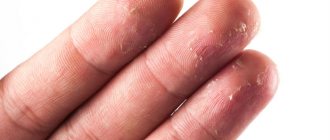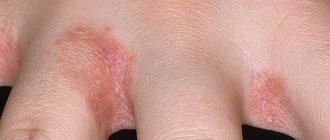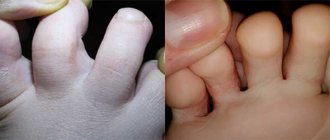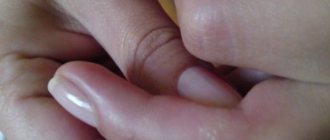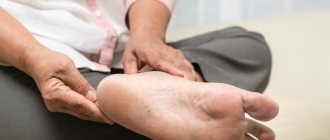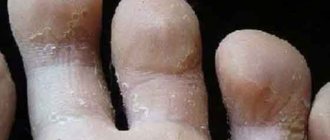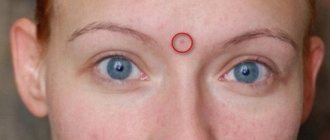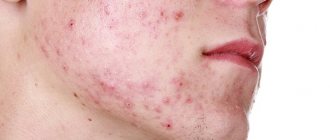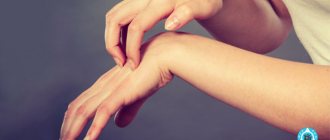Causes
Redness and itching can be caused by many factors. Among them are:
- infection (bacterial or fungal),
- eczema, psoriasis, dermatitis,
- allergies to food, household chemicals, dyes,
- the presence of parasites in internal organs,
- avitaminosis,
- hormonal imbalance,
- scarlet fever (when the disease occurs in children, redness of the fingers occurs, a rash and itching in the child are noted),
- dysfunction of the kidneys and gall bladder.
As you can see, quite a few reasons can contribute to the appearance of irritation between the fingers. Poor quality care may also be the cause. Women should use cosmetics intended for their age group.
It is necessary to take this issue seriously and carry out a set of measures to cleanse, nourish and moisturize the integument. This is the only way to compensate for the lack of nutrients and vitamins.
Another provoking factor is changing weather conditions. If you intend to go on vacation and are heading from frosty Arkhangelsk straight to hot Turkey, be prepared for the appearance of unpleasant symptoms.
No matter how trivial it may sound, even prolonged exposure to direct sunlight can disrupt the natural balance of the skin due to increased moisture between the fingers. If this happens, it is necessary to temporarily limit direct contact with water.
A more rare cause of redness is an insufficient amount of vitamins A or E in the body, as well as other important nutrients.
Health diagnostics by hand
Today we are talking about diagnosing a person’s health condition by hand. Of course, it is right for health diagnostics to be carried out by specialists, but it is no secret that we usually turn to doctors when a disease has already occurred.
Modern technologies in medical diagnostics make it possible to make a more accurate diagnosis than just a visual examination. But nevertheless, in order not to start the disease, it is very important to independently learn to recognize its first signs at the very beginning in order to take action in time.
Look at your hands. Their appearance is an indicator of your health status. If your hands are even, smooth and warm, and have a pink color, then we can say that you are healthy.
And yet, compare the condition of your hands with the description of external manifestations that indicate diseases of the internal organs. If you find any similarities in yourself, do not immediately panic, because modern life also has an impact on our appearance, including our hands and nails. But don’t be careless, perhaps it’s time to consult a doctor. By the way, you can read an article about diagnosing diseases by nails here.
Health diagnostics by hand
Hand shape
- Wide palms are a sign of strength, endurance and resistance to colds. But at the same time, owners of such hands and short fingers are often susceptible to increased blood pressure and are prone to heart disease. Usually their metabolic processes are slow, the thyroid gland works slowly and, as a result, hypothyroidism and excess weight accompany them throughout life.
- Narrow palms are a sign of weather dependence and instability of the nervous system. Often the owners of such hands with smooth, long fingers are hypotensive and prone to depression with constantly freezing hands and feet due to impaired peripheral circulation.
- Small hands are a sign of an unstable autonomic nervous system. People with such hands often suffer from bronchopulmonary diseases, hypotension and problems in the functioning of the rectum.
Hand color
- Red palms are a sign of toxic liver damage
- Yellow palms – liver and gallbladder diseases
- Brown spots on the back of the hand are a sign of aging (uric acid is not excreted by the kidneys and appears on the skin); if you are young, then you should pay attention to the functioning of the gallbladder.
- A marble pattern on the palm is a disturbance in the autonomic system or is it the first signs of frostbite
- Spots on the heights of the palms near the base of the thumbs are a sign of diseases of the genital organs
- Blue fingers, especially when exposed to cold, are a sign of rheumatic diseases and Raynaud's disease (severe vasospasm due to frost)
- Dark red fingertips – pay attention to the kidneys and liver
- Blue spots on the fingers are a sign of disorders in the digestive system
- The lines on the palms have become dark - a sign of Addison's disease (a disorder of the production of hormones by the adrenal glands)
- The lines on the palms of the hands have turned unnaturally white - a clear sign of anemia (there is not enough hemoglobin in the blood)
- White fingers and at the same time very cold – vegetative-vascular dystonia and often low blood pressure.
Local palm temperature
- Cold palms - impaired peripheral circulation due to lack of vitamins and, especially, nicotinic acid
- Burning palms are a clear sign of intoxication of the body during any infection or poisoning. This is how the liver reacts, actively releasing toxins into the blood
Hand skin condition
- Wet hands are signs of hyperthyroidism (hyperthyroidism)
- Dry and pale hands – on the contrary, hypothyroidism (hypothyroidism)
- Fine peeling of the skin on the palms of the hands is a sign of a lack of vitamins A and D
- Peeling in large plates is a sign of a fungal disease
- Deep folds on the back of the fingers near the nail are a sign of diabetes
- Changes in elasticity (roughness) of the back of the index finger are a sign of gallbladder dysfunction
- Thick, swollen skin with fleshy palms is a manifestation of decreased metabolism and sometimes cancer
Finger joints
- Little fingers that are difficult to bend and straighten are a heart problem
- Puffiness and swelling of the joints and at the same time pain - polyarthritis is possible
- Crunchy fingers are a sign of calcium and silicon deficiency
- Gutta-percha joints (bend in all directions) – you need to check your liver function
- Deformed joints (growths, curvatures) - arthrosis
- Fingers that look like “drumsticks” with nails in the form of “watch glasses” - the development of heart or lung disease (bronchial asthma)
Unusual sensations in the hands
- “Creepiness” - problems of the endocrine system
- Little fingers go numb - you need to check your cardiovascular system
- Numbness of the thumbs - respiratory system disorders
- Itching of the index finger, especially its lateral surface - disturbances in the functioning of the large intestine
Diagnosis of health based on pain in the hands
1,2 – Pressing on the points on the bend of the nail and middle phalanx of the index and ring fingers causes pain. This indicates problems in the knee joints.
3 – The occurrence of pain when pressing the tubercle at the base of the thumb indicates problems with the lungs. On the right hand is the right lung, on the left, respectively.
4 – If you press on a point that is located in the hollow between the hand and forearm on the back of the thumb and pain appears, then we can talk about coronary heart disease.
5 – Pain when pressing the tubercle of the palm between the index and middle fingers indicates a disease of the genitourinary system
6 – pain in the center of the palm indicates intoxication of the body and decreased immunity
7 – This point can be found if you bend all the fingers of the hand towards the palm with even phalanges (without squeezing into a fist), then the little finger will point to the point in the lower corner of the palm. If pain appears here, then you need to pay attention to the functioning of the gallbladder and liver.
Everything you have read in this article indicates possible problems with your health and is a reminder that you need to take action in time and consult a doctor.
There is no need to be overly suspicious, but at the same time overly careless. Just be attentive to yourself and your loved ones.
@M. Antonova
———————————————————
You can read more interesting and useful articles MEDIMARI
- What does a person's pulse say?
- What heart rate is considered normal?
- Bad breath or halitosis
- A person’s appearance is an indicator of health
- Fatigue or chronic fatigue syndrome?
- Table of main indicators of general blood test
- Your nails speak about your health
We recommend watching:
Fungus
One of the most unpleasant and common contagious skin diseases is called mycosis. It is provoked by a fungal pathogen. The disease develops quickly under favorable conditions: weakened immunity, past infections, addictions.
Infection occurs quite easily - it is enough to touch the things of a sick person or come into contact with him. The largest tissue damage occurs in the nail area. The symptoms begin this way: most often, after a shower, redness appears between the fingers, which, in addition, also itches. The edge of the nail plate changes its shape, which is accompanied by painful sensations. Then it becomes deformed, brittle and weak.
Important! If the development of the fungus is not stopped at this stage, then red spots appear all over the body.
The red big toe also hurts. Big toe hurts - causes
To get rid of excruciating pain, you need to find out the cause as quickly as possible and try to eliminate it. The huge number of factors that cause big toe pain does not allow us to consider all of them in detail, but it is advisable to know the most common ones.
1. Gout
The main cause of the “aristocratic” disease is a violation of proper metabolism. Crystals of uric acid derivatives of sodium urate are deposited in the joints and gradually lead to its destruction. As a rule, an attack of gouty arthritis begins with a sharp pressing pain, often at night. First, the big toe hurts excruciatingly, then the accompanying symptoms rapidly increase - redness of the skin around the joint, swelling of the tissues, the temperature in the affected area rises, and the pain spreads up the leg. During the day it becomes a little easier, but at night the unbearable pain returns with renewed vigor. The inflammatory process can cause suffering for several days and even weeks. Exacerbations of gout are possible up to several times during the year, and their main causes are:
- alcohol abuse;
- the presence of too many fatty foods on the menu;
- passion for strong tea and coffee.
It is impossible to get rid of frequent gout attacks without following a proper diet. People of strong stature suffer from the disease more often, after forty years. Other joints can also become the target of gout attack.
2. Arthrosis
The disease often plagues beautiful ladies and is evidence of their defeat in an unequal duel with capricious fashion. Wanting to keep up with the latter's rapid pace, the women bravely squeeze into narrow-toed high-heeled shoes and with a sweet smile endure the discomfort and merciless squeezing of their toes for a long time. The result is curvature of the thumb, the appearance of an unesthetic “bone” and deformation of the joint. A periodically occurring inflammatory process leads to an increase in the problem - the big toe hurts more and more noticeably, at first only after a long walk, and later at rest.
3. Uncomfortable shoes can cause another problem - ingrown toenails. In addition to tight shoes, this can also be caused by cutting your nails too short and improperly rounding their edges. In this case, the big toe hurts severely, the skin around the nail is red and swollen, and pus accumulates inside. It is unlikely that you will be able to deal with the problem on your own; you need to immediately contact a specialist.
4. Morton's neuroma
The disease occurs due to the degeneration of fibrous tissue and its significant thickening as a result of wearing uncomfortable high-heeled shoes, excessive loads on the feet, injuries and flat feet. The source of pain occurs at the level of the fourth and third fingers, but the big one also suffers. The pain is felt at the base of the toes and affects only one leg. It occurs due to pinching of certain nerve endings, gradually intensifies and makes even simple walking impossible.
Allergic dermatitis
This disease is not contagious, its nature comes from the specifics of the immune system: when any harmful element appears, it tries to overcome it through a powerful release of histamine into the blood. As a result, the blood vessels dilate and a rash, inflammation, and itching appear on the skin. Therefore, even in this case, if redness appears between the fingers, it is necessary for an allergist to prescribe treatment.
There is a second scenario for the development of events. The first sign may be ordinary dry skin, which remains unattended and begins to develop.
Allergies can occur due to the action of various pathogens: plant pollen, chemicals, medications, animal hair, food additives, perfumes, building materials, insect bites. This subtype of allergic skin reaction, like urticaria, involves red spots with a circumference of about 10 cm. They can pass without a trace, but itching, fever and severe weakness persist for some time.
Red finger on finger. Symptoms
The bone grows gradually, with worsening symptomatic manifestations. The physiological deviation of the big toe from the metatarsal bone is 10 degrees.
- The initial stage of changes in the joint and bone of the finger is marked by a slight displacement of about 20 degrees. This does not cause pain or discomfort, except that it is an aesthetic drawback;
- the displacement reaches 30 degrees, the growing bone begins to cause some discomfort - the legs hurt slightly after walking;
- with continued displacement of the thumb up to 50 degrees, the bone begins to hurt, the skin over it is red and swollen, the joint is limited in mobility;
- a deviation of more than 50 degrees causes serious discomfort - patients report severe pain, problems with movement, and difficulty finding shoes.
Discomfort is caused by pressure on the head of the first metatarsal bone, especially when the foot is in a shoe.
You can recognize the appearance of a bunion by the initial signs: increased fatigue of the legs, the feet swell, there is hyperemia and aching, almost constant pain in the toe area, in the morning when trying to get out of bed the foot reacts with acute pain, the formation of frequent calluses. At this stage, it is already advisable to seek qualified treatment.
When the joint on the big toe hurts, this can be caused not only by deformation of the metatarsal bones of the foot due to flattening of the arches, but also by some other diseases (which can be combined with the growth of the bone):
- Bursitis is an inflammation of the joint capsule of the toe. Injuries to the articular joints of the toes are quite common, as is the chronicity of their inflammation, which leads to severe pain in the big toe and the entire foot.
- Gouty arthritis is a disease caused by a violation of the metabolism of uric acid salts, the crystals of which are deposited in the joints. Gout, as a rule, begins to manifest itself as very severe pain and inflammation in the thumbs, which later spreads to the remaining joints of the limbs. The thumb swells and the skin becomes hyperemic. As the disease progresses, the bone tissue of the joints atrophies, and specific nodes - tophi - appear in the soft tissues of the foot.
Eczema
Very often, eczema begins with peeling and dry skin between the fingers.
This is a dermatological disease that manifests itself with the following symptoms:
- thickening and peeling of the epithelium,
- the appearance of a rash in the form of blisters,
- the appearance of itching,
- deterioration of skin color.
The nature of the disease is different - it occurs both as a result of ill health of the internal organs and as a reaction to chemicals.
Most often, people working in the fields of pharmaceuticals, construction, cosmetology, cleaning, agriculture, and food processing factories are susceptible to eczema.
The specificity of the treatment of this disease is such that, due to severe itching, patients scratch the affected areas of the skin until they bleed, which also causes a bacterial infection. In addition, small bubbles with liquid, skin thickening, and swelling appear. Eczema and allergies should not be confused, since these diseases have different natures and, accordingly, different treatments.
It is important to know! Eczema is a very dangerous disease, from which it is impossible to cure, since it goes into remission.
Lichen
Such an unpleasant disease as lichen can spread to a person from a domestic or street animal, and even from touching the sand on which it was sitting. The disease appears in the form of pink spots with a red rim; they quickly increase in size and spread throughout the body. In this case, you cannot practice self-medication; you must consult a doctor who will prescribe medications in the form of ointments and cauterization with iodine.
Other reasons
Avitaminosis. Most often it appears in the spring, due to a deficiency of nutrients and vitamins in the body, and is not a serious disease. To treat dry skin and redness between the fingers, you need to eat more seasonal vegetables and fruits, citrus fruits.
Household chemicals. With constant contact with strong substances, redness and rash may appear on the hands, which may indicate the development of eczema or dermatitis.
A common cause of flaking and dry skin can be genetic predisposition, excessive use of soap, as well as other hygiene products. In addition, damage to other parts of the body is possible.
Irritation and redness of the skin can result from insect bites. A particle of poison entering the epidermis causes a local allergic reaction in the body.
Additional diagnostics
Additional research will help put an end to the question of the origin of white spots. Based on the specific situation, the doctor will recommend undergoing a number of diagnostic procedures:
- General blood analysis.
- Biochemical tests (antibodies to infections, rheumatic tests).
- Scraping from affected areas and microscopy.
- Examination under Wood's lamp.
- Capillaroscopy, etc.
In unclear cases, the dermatologist can refer the patient for consultation with related specialists (rheumatologist, infectious disease specialist, endocrinologist, immunologist or cardiologist). And having received the necessary information, he makes a final diagnosis. It is then that the patient finds out the exact cause of the appearance of white spots on the arm.
Medicines
To relieve itching and inflammation, antihistamines are prescribed, such as Claritin, Cetrin, Fenistil, Suprastin, Loratadine.
If there are bacteria in the body, they must be suppressed with the help of antibiotics. Which pills should be taken can only be decided by your doctor. As for local external treatment, Erythromycin ointment and other creams that protect inflamed skin areas from the spread of microbes are excellent.
Hormonal ointments (Clotrimazole, Miconazole, Ketonazole) are used to suppress fungal infections. If the test results reveal mycosis, the doctor may also prescribe boric acid, rivanol or resorcinol.
In turn, hormonal ointments are also used for dermatitis. The following drugs are suitable: Lokoid, Advantan, Fucicort. They will also help in the treatment of psoriasis. In addition to the above-mentioned remedies, tar and zinc ointment are used; these preparations are based on solid oil (Solipsor, Kartalin, Magnipsor).
Traditional methods
These treatment methods are used strictly after visiting a doctor and prescribing the necessary medications. Folk remedies are only an addition to the main treatment. The following procedures have proven themselves to be effective:
- First pour boiling water over the blueberries (100 grams), then cool, and apply the crushed berries, wrapped in gauze, to the source of inflammation.
- Olive oil has healing properties. They can be used to rub problem areas. Everyone also knows the beneficial properties of sesame oil.
- Grate the carrots on a fine grater, wrap in gauze, and apply to the reddened area of the skin.
